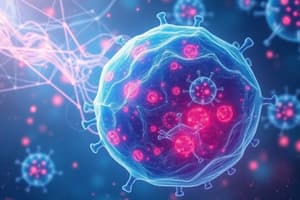Podcast
Questions and Answers
What is a key management step for severe angioedema?
What is a key management step for severe angioedema?
- Increased hydration
- Immediate administration of epinephrine (correct)
- Administration of antihistamines only
- Application of topical corticosteroids
Which symptom is associated with acute urticaria?
Which symptom is associated with acute urticaria?
- Persistent dry skin
- Severe redness and scaling
- Raised, itchy welts (correct)
- Swelling of deeper skin layers
How is chronic dermatitis primarily managed?
How is chronic dermatitis primarily managed?
- Immediate cessation of all cosmetics
- Using oral antihistamines exclusively
- Topical corticosteroids and avoiding triggers (correct)
- Frequent exposure to irritants
What distinguishes allergic contact dermatitis from irritant contact dermatitis?
What distinguishes allergic contact dermatitis from irritant contact dermatitis?
What management strategy is recommended for atopic dermatitis?
What management strategy is recommended for atopic dermatitis?
Which type of hypersensitivity reaction is characterized by IgE-mediated responses and causes symptoms within minutes?
Which type of hypersensitivity reaction is characterized by IgE-mediated responses and causes symptoms within minutes?
What are the common symptoms of allergic rhinitis?
What are the common symptoms of allergic rhinitis?
Which of the following is considered a long-term control medication for asthma management?
Which of the following is considered a long-term control medication for asthma management?
What is the primary management strategy for food allergies?
What is the primary management strategy for food allergies?
Which immunotherapy technique involves injections and requires long-term commitment?
Which immunotherapy technique involves injections and requires long-term commitment?
Anaphylaxis can be triggered by which of the following?
Anaphylaxis can be triggered by which of the following?
Which classification is used for asthma when symptoms occur more than 2 days per week?
Which classification is used for asthma when symptoms occur more than 2 days per week?
What type of hypersensitivity reaction is associated with the destruction of host cells?
What type of hypersensitivity reaction is associated with the destruction of host cells?
Flashcards are hidden until you start studying
Study Notes
Hypersensitivity Reactions
- Definition: Exaggerated immune response to an allergen, classified into four types:
- Type I (Immediate): IgE-mediated responses; symptoms occur within minutes (e.g., anaphylaxis, allergic rhinitis).
- Type II (Cytotoxic): IgG or IgM-mediated; involves destruction of host cells (e.g., hemolytic anemia).
- Type III (Immune Complex): Involves immune complexes; responsible for conditions like serum sickness.
- Type IV (Delayed): T-cell mediated; symptoms appear after hours to days (e.g., contact dermatitis).
Allergic Rhinitis
- Definition: Allergic inflammation of the nasal mucosa.
- Symptoms: Sneezing, nasal congestion, itching, rhinorrhea, conjunctivitis.
- Causes: Seasonal (pollen) or perennial (dust mites, pet dander).
- Management: Antihistamines, nasal corticosteroids, decongestants, and allergen avoidance.
Asthma Management
- Definition: Chronic inflammation of the airways leading to wheezing, coughing, and breathing difficulties.
- Classification:
- Intermittent: Symptoms ≤ 2 days per week.
- Persistent: Symptoms > 2 days per week.
- Management:
- Quick-relief: Short-acting beta-agonists (SABAs).
- Long-term control: Inhaled corticosteroids, leukotriene receptor antagonists, long-acting beta-agonists (LABAs).
- Monitoring: Peak flow monitoring and regular follow-up.
Food Allergies
- Definition: Immune responses to specific food proteins.
- Common Allergens: Milk, eggs, peanuts, tree nuts, soy, wheat, fish, shellfish.
- Symptoms: Range from mild (hives, itching) to severe (anaphylaxis).
- Management: Strict avoidance of allergens, emergency action plan, use of epinephrine auto-injector for anaphylaxis.
Immunotherapy Techniques
- Allergen Immunotherapy: Gradual desensitization to specific allergens.
- Types:
- Subcutaneous immunotherapy (SCIT): Involves injections; requires long-term commitment.
- Sublingual immunotherapy (SLIT): Administered via tablets/drops; more convenient but less widely used.
- Indications: Effective for allergic rhinitis, asthma, and certain insect allergies.
Anaphylaxis
- Definition: Severe, potentially life-threatening allergic reaction.
- Causes: Foods, insect stings, medications, latex.
- Symptoms: Difficulty breathing, swelling of throat/tongue, rapid heartbeat, rash, low blood pressure.
- Management: Immediate administration of epinephrine, call emergency services, and secondary treatments (antihistamines, corticosteroids).
Urticaria
- Definition: Skin condition characterized by raised, itchy welts (hives).
- Acute vs. Chronic:
- Acute: Lasts less than six weeks; often related to allergic reactions.
- Chronic: Lasts longer than six weeks; may have underlying causes.
- Management: Antihistamines, avoidance of triggers, corticosteroids for severe cases.
Angioedema
- Definition: Swelling of the deeper layers of the skin, often associated with urticaria.
- Causes: Allergic reactions, medications, hereditary factors.
- Symptoms: Swelling of the face, lips, eyes, and sometimes the throat.
- Management: Antihistamines, corticosteroids, and if severe, epinephrine.
Atopic Dermatitis
- Definition: Chronic inflammatory skin condition, often related to allergies.
- Symptoms: Dry, itchy skin, often with redness and scaling.
- Management: Moisturizers, topical corticosteroids, calcineurin inhibitors, and avoiding irritants.
Contact Dermatitis
- Definition: Skin rash resulting from contact with an allergen or irritant.
- Types:
- Allergic contact dermatitis: Immune-mediated reaction (e.g., to latex, poison ivy).
- Irritant contact dermatitis: Non-immune reaction to chemicals or friction.
- Symptoms: Redness, itching, blistering at the contact site.
- Management: Identification and avoidance of triggers, topical corticosteroids for inflammation.
Hypersensitivity Reactions
- Exaggerated immune responses to allergens, classified into four types:
- Type I (Immediate): IgE-mediated response causing symptoms within minutes, examples include anaphylaxis and allergic rhinitis.
- Type II (Cytotoxic): IgG or IgM-mediated involving the destruction of host cells, example is hemolytic anemia.
- Type III (Immune Complex): Involves immune complexes, associated with conditions like serum sickness.
- Type IV (Delayed): T-cell mediated causing symptoms after hours to days, example is contact dermatitis.
Allergic Rhinitis
- Allergic inflammation of the nasal mucosa causing sneezing, nasal congestion, itching, rhinorrhea, and conjunctivitis.
- Triggered by seasonal allergens like pollen or perennial allergens like dust mites and pet dander.
- Management involves antihistamines, nasal corticosteroids, decongestants, and allergen avoidance.
Asthma Management
- Chronic inflammation of the airways causing wheezing, coughing, and breathing difficulties.
- Classified by symptom frequency:
- Intermittent: Symptoms ≤ 2 days per week.
- Persistent: Symptoms > 2 days per week.
- Managed with two types of medications:
- Quick-relief: Short-acting beta-agonists (SABAs).
- Long-term control: Inhaled corticosteroids, leukotriene receptor antagonists, long-acting beta-agonists (LABAs).
- Requires peak flow monitoring and regular follow-up.
Food Allergies
- Immune responses to specific food proteins, common examples are milk, eggs, peanuts, tree nuts, soy, wheat, fish, and shellfish.
- Symptoms range from mild (hives, itching) to severe (anaphylaxis).
- Management focuses on strict avoidance of allergens, an emergency action plan, and use of epinephrine for anaphylaxis.
Immunotherapy Techniques
- Gradual desensitization to specific allergens, two types:
- Subcutaneous immunotherapy (SCIT): Involves injections, requires long-term commitment.
- Sublingual immunotherapy (SLIT): Administered via tablets/drops, more convenient but less widely used.
- Effective for allergic rhinitis, asthma, and certain insect allergies.
Anaphylaxis
- A severe, potentially life-threatening allergic reaction caused by foods, insect stings, medications, and latex.
- Characterized by difficulty breathing, swelling of the throat/tongue, rapid heartbeat, rash, and low blood pressure.
- Requires immediate administration of epinephrine, calling emergency services, and secondary treatments like antihistamines and corticosteroids.
Urticaria
- Skin condition characterized by raised, itchy welts (hives), two categories:
- Acute: Lasts less than six weeks, often related to allergic reactions.
- Chronic: Lasts longer than six weeks, may have underlying causes.
- Management involves antihistamines, avoidance of triggers, and corticosteroids for severe cases.
Angioedema
- Swelling of the deeper layers of the skin, often associated with urticaria caused by allergic reactions, medications, or hereditary factors.
- Symptoms include swelling of the face, lips, eyes, and sometimes the throat.
- Management involves antihistamines, corticosteroids, and if severe, epinephrine.
Atopic Dermatitis
- Chronic inflammatory skin condition, often related to allergies, characterized by dry, itchy skin, often with redness and scaling.
- Management includes moisturizers, topical corticosteroids, calcineurin inhibitors, and avoiding irritants.
Contact Dermatitis
- Skin rash resulting from contact with an allergen or irritant, classified into two types:
- Allergic contact dermatitis: Immune-mediated reaction to substances like latex or poison ivy.
- Irritant contact dermatitis: Non-immune reaction to chemicals or friction.
- Symptoms include redness, itching, and blistering at the contact site.
- Management involves identifying and avoiding triggers and using topical corticosteroids for inflammation.
Studying That Suits You
Use AI to generate personalized quizzes and flashcards to suit your learning preferences.



